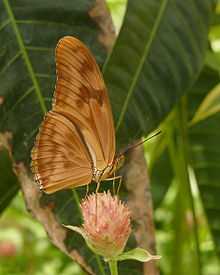Dryas iulia
| Dryas iulia | |
|---|---|
| | |
| Dorsal view | |
 | |
| Ventral view | |
| Scientific classification | |
| Kingdom: | Animalia |
| Phylum: | Arthropoda |
| Class: | Insecta |
| Order: | Lepidoptera |
| Family: | Nymphalidae |
| Tribe: | Heliconiini |
| Genus: | Dryas Hübner, [1807] |
| Species: | D. iulia |
| Binomial name | |
| Dryas iulia (Fabricius, 1775) | |
| Subspecies | |
|
14 ssp., see text | |
| Synonyms | |
|
Genus: | |
Dryas iulia (often incorrectly spelled julia),[1] commonly called the Julia Butterfly, Julia Heliconian, The Flame, or Flambeau, is a species of brush-footed butterfly. The sole representative of its genus Dryas, it is native from Brazil to southern Texas and Florida, and in summer can sometimes be found as far north as eastern Nebraska. Over 15 subspecies have been described.
Its wingspan ranges from 82 to 92 mm, and it is colored orange (brighter in male specimens) with black markings; this species is somewhat unpalatable to birds and belongs to the "orange" Batesian Mimicry mimic complex.[2]
This butterfly is a fast flier and frequents clearings, paths, and margins of forests and woodlands. It feeds on the nectar of flowers, such as lantanas (Lantana) and Shepherd's-needle (Scandix pecten-veneris), and the tears of caiman, the eye of which the butterfly irritates to produce tears.[3] Its caterpillar feeds on leaves of passion vines including Passiflora affinis and Yellow Passionflower (P. lutea) in Texas.
The species is popular in butterfly houses because it is long-lived and active throughout the day.
Subspecies
Listed alphabetically.[4]
- D. i. alcionea (Cramer, 1779)
- D. i. carteri (Riley, 1926)
- D. i. delila (Fabricius, 1775)
- D. i. dominicana (Hall, 1917)
- D. i. framptoni (Riley, 1926)
- D. i. fucatus (Boddaert, 1783)
- D. i. iulia (Fabricius, 1775)
- D. i. lucia (Riley, 1926)
- D. i. largo Clench, 1975
- D. i. martinica Enrico & Pinchon, 1969
- D. i. moderata (Riley, 1926)
- D. i. nudeola (Bates, 1934)
- D. i. warneri (Hall, 1936)
- D. i. zoe Miller & Steinhauser, 1992
-

Dryas iulia alcionea MHNT
-

Dryas iulia dominicana MHNT
-
_at_Jacksonville_Zoo_(2).jpg)
-
_at_Jacksonville_Zoo_(9).jpg)
-
Caterpillar
-
.jpg)
Two adults
-

Two more adults. Note variable coloration.
-
.jpg)
Adult showing underside of wings
References
- ↑ 1.0 1.1 Lamas, G. (editor) (2004). Atlas of Neotropical Lepidoptera. Checklist: Part 4A. Hesperioidea - Papilionoidea. ISBN 978-0-945417-28-6
- ↑ Pinheiro, Carlos E. G. (1996): Palatability and escaping ability in Neotropical butterflies: tests with wild kingbirds (Tyrannus melancholicus, Tyrannidae). Biol. J. Linn. Soc. 59(4): 351–365. doi:10.1111/j.1095-8312.1996.tb01471.x (HTML abstract)
- ↑ Patrick Barkham and Camilla Turner guardian.co.uk, Wednesday 6 April 2011, http://www.guardian.co.uk/environment/2011/apr/06/sensational-butterflies-natural-history-museum
- ↑ Dryas, funet.fi
- Butterflies and Moths of North America (BMNA) [2008]: Julia Heliconian. Retrieved 2008-AUG-14.
- Miller, L. D. & Miller, J. Y. (2004): The Butterfly Handbook: 115. Barron's Educational Series, Inc., Hauppauge, New York. ISBN 0-7641-5714-0
External links
![]() Media related to Dryas julia at Wikimedia Commons
Media related to Dryas julia at Wikimedia Commons
![]() Data related to Dryas (Nymphalidae) at Wikispecies
Data related to Dryas (Nymphalidae) at Wikispecies
